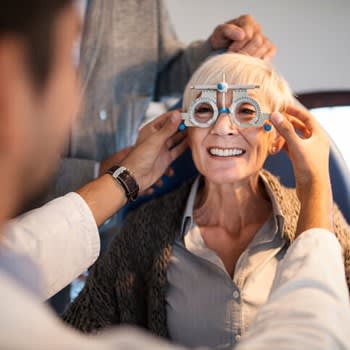The Incredible Human Experience: How Many Senses Are There?
- Discover why what you've learned about our senses is probably outdated. Still believe sight, sound, smell, touch and taste are the only senses? Think again.
The idea that we have five senses has been around a long time — around 2,400 years, to be more precise. The Ancient Greek philosopher, Aristotle, theorized that vision, hearing, smell, taste and touch were the internal processes that allow us to interact with the external world, long before brain scans, optogenetics and brain-computer interfaces. These days, technology and neuroscience have come a long way, and it turns out there are probably a lot more than five senses.

Learn More About Medicare
Join our email series to receive your free Medicare guide and the latest information about Medicare.
By clicking "Sign me up!" you are agreeing to receive emails from HelpAdvisor.com
Thanks for signing up!
Your free Medicare guide is on the way.
Make sure to check your spam folder if you don't see it.
How Many Senses Are There?
Experts argue there are as many as 33 senses, but nine at the very least. They don't yet agree on exactly how many senses people have. However, most believe that the way humans interact with the world is more complex and nuanced than previously thought.
Many of the additional senses have gone under the radar because there's no visible organ associated with them. We can see the eyes, ears, nose and tongue, and feel touch first-hand. Extra senses, such as balance, temperature, tension, pain and thirst, seem a lot less tangible because the work goes on unseen, underneath the skin and within the brain.
Vision
Sight is one of the main ways people interact with the world around them. However, modern science suggests vision can be broken down further:
- Light: There are rods in the eye that are responsible for specifically sensing light at low levels, so some experts break light and color down into two separate visual senses.
- Color: We use receptors called cones in the visual system to perceive color when light levels are higher. However, some scientists go further and suggest that color vision can be further broken down into an additional three senses.
- Red, green and blue: Unlike most mammals, which have the ability to perceive two primary colors, humans can detect three. As such, it could be argued that people have four visual senses: light and the three colors.
Hearing
As human senses go, hearing is one of the most straightforward and singular. The ear drums detect vibrations and different frequencies, which we perceive as sound.
Smell
Smell is another singular sense, but we have around 400 receptors to distinguish one scent from another. What's more, there are around 6 million receptor sites in each person's nose, allowing us to smell up to 1 trillion different odors.
Taste
Although taste can be thought of as a single sense, we have up to 4,000 taste buds that detect five distinct types of flavor:
- Sweet
- Salty
- Sour
- Bitter
- Umami
Some experts argue that there are four or five gustatory senses, taking into account the different types of taste we can detect.
Touch
Touch isn't just a means of interacting with the world; it's essential for child development and happiness throughout life. It conveys compassion between people, reinforcing social bonds, offering reassurance and lifting mood.
Generally speaking, experts agree that pressure and light touch are the two tactile senses. They're distinct because light touch occurs when the tiny hairs on your body move, for instance, in a breeze. Pressure involves direct contact with the skin, such as when you hug someone or squeeze your wrist.
Some might argue that pain and temperature perception are tactile senses, but others disagree because they involve additional parts of the brain involving the nervous system and maintenance of homeostasis.
Nocioception
Pain was once thought of as a tactile sense or reaction to other senses being overloaded, but the brain and body have a dedicated system for regulating it. Furthermore, some experts believe it's three senses due to the different types of pain receptors:
- Visceral: Relating to the blood vessels and internal organs
- Somatic: Felt in the muscles, soft tissue, skin and bones
- Neuropathic: Pain experienced by people with specific injuries/illnesses
Thermoception
Keeping the body at a steady, consistent temperature is one of the central nervous system's most crucial roles. If the right balance between hot and cold isn't maintained, our risk of illness or injury soars. Scientists tend to agree that temperature perception should be broken down into two separate senses because heat and cold are processed separately in the brain.
Mechanoreception
While touch explains how we physically interact with the world, mechanoreception relates to how we perceive our bodies in relation to the outside world. For example, knowing to duck down to avoid hitting something directly ahead of you. Conservative estimates suggest mechanoreception and balance are the two main senses in this category. However, some experts argue it can be split into an additional five senses:
- Rotational acceleration causes us to turn our heads in response to stimuli
- Linear acceleration, which is mostly associated with our ability to navigate our bodies in relation to the earth's gravitational force
- Proprioception describes the way we can sense where our limbs are in relation to our body
- Kinesthesis is similar to proprioception but relates to being able to sense and control the pace and direction our limbs move at
- Golgi tendon organ detects how much muscle tension a person exerts
- Muscle spindles sense the rate of lengthening of a given muscle
Interoception
Interoception is all about how we sense our internal bodily signals. For example, if you sit still in a quiet area and bring your focus to yourself, you might be able to feel your heart beating — or even count the beats. Some people can sense their body's internal state much easier than others, making it a challenging sense to study and an area of interest for research. Scientists think interoception consists of up to 11 senses, including the ability to perceive:
- Blood pressure
- Arterial blood pressure
- Central nervous blood pressure
- Head blood pressure
- Blood oxygen content
- Cerebrospinal fluid PH
- Plasma osmotic pressure (thirst)
- Artery-vein blood glucose difference (hunger)
- Lung inflation
- Bladder stretch
- Full stomach
Is Speech a Human Sense?
The abilities to speak and perceive speech are unique to humans, and some people would argue that they're so important to our experience of the outside world that they're senses. However, others would say that speech is a learned skill made possible by humanity's large brains and results from our unique ability to process senses. Although we sense how to speak from others and learn about the world using speech, the ability to speak is more of a process.
What Is the Most Powerful Sense?
Humans have a large area of the brain dedicated to processing visual information, so experts tend to agree that vision is our most powerful sense. While a dog or cat relies most heavily on their acute sense of smell for survival and learning purposes, we use vision.

